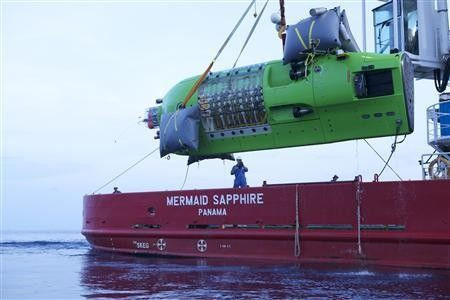James Cameron Deep Sea Dive: Director Calls Mariana Trench, Deepest Section Of The Earth, 'Another Planet'

Oscar-winning director James Cameron has resurfaced on Monday after diving to one of the deepest known sections of the Earth, the Challenger Deep in the Mariana Trench.
His solo dive into the Challenger Deep, part of the Mariana Trench in the western section of the Pacific Ocean, left Cameron feeling as he had was completely isolated from the rest of world, he said according to CNN.
I felt like I literally in the space of one day have gone to another planet and come back, reported CNN.
Approximately 8 a.m. local time, the National Geographic explorer and filmmaker entered into the water. He descended more than 10,900 meters, or approximately 35,800 feet, into the Mariana Trench, a section of the ocean that is deeper than the Mount Everest is tall.
Cameron was the first person to make this dive alone, doing so several hours before he was set to attend the premiere of Titanic 3-D in London.
Cameron descended into the great unknown with his custom designed vessel that was being constructed for the past eight years, the Deepsea Challenger.
It's a completely alien world, he said, reported CNN. The bottom of the trench was very soft, almost gelatinous, flat plane, almost featureless, he continued to say.
I just sat there looking out the window, looking at this barren, desolate lunar plain, appreciating, Cameron said, according to ABC.
He was even able to use social media to tell his fans where he was while submerged.
Hitting bottom never felt so good. Can't wait to share what I'm seeing w/ you, the 57-year-old filmmaker said in a Twitter message, just as he touched down in the trench.
Unfortunately, was unable to see any fantastic creatures.
We'd all love to think there are giant squid and sea monsters down there, said Cameron. We can't rule it out, but my bet is there aren't. What you're going to find is these very, very interesting animals, the likes of which we've never seen before, that have adapted to this extreme environment.
He saw some shrimp-like creatures that appeared to mostly scavengers that eat dead fish or whales that sink to bottom of the ocean.
When I came to Challenger Deep, the bottom was completely featureless, he said. I had this idea that life would adapt to the deep ... but I don't think we're seeing that.
It is estimated that approximately 750,000 marine species have not been formally discovered.
While he investigated, he collected samples for continued research in marine biology, microbiology, astrobiology, marine geology and geophysics, said National Geographic. He believes the samples could contain exotic species of microbial life forms that could greatly advance the understanding of the ocean.
He described the depth as a cold and dark, completely black world that's devoid of sunlight, he said, reported CNN.
Cameron had planned to spend approximately six hours in the trench, but his trip was suddenly cut short due to mechanical issues.
I lost hydraulics toward the latter part of dive, and I was unable to use the manipulator arm, Cameron said Monday morning, according to the National Geographic.
He quickly made an ascent, which took approximately 70 minutes. However, Cameron is excited for his return trip to the Mariana Trench.
The important thing is that we have a vehicle that's a robust platform-it gets us there safely, the lights work, the cameras work, and hopefully next time the hydraulics will work.
He said he sees this trip as the beginning of what is to come and the opening up this frontier to science and really understanding these deep places, he said according to National Geographic.
© Copyright IBTimes 2024. All rights reserved.





















